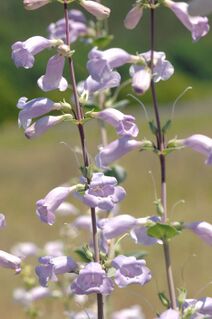Penstemon grandiflorus
| Penstemon grandiflorus | |
 | |
| Light: | |
| Moisture: | |
| Hardiness: | 3 |
| Soil pH: | 5.6-8.4 |
| Height: | 4' |
| Blooms: | Mid Summer-Late Summer |
| Native to: | |
| Medicinal Rating: | |
| Tea: | Yes |
Penstemon grandiflorus (common name: large beardtongue)
Propagation: Seed - sow late winter in a greenhouse[1]. When they are large enough to handle, prick the seedlings out into individual pots and plant them out in late spring.
Alternatively, the seed can be sown in early summer in a greenhouse, the seedlings overwintered in the greenhouse and then planted out in the following spring[1].
Division in autumn[2].
Cuttings can be taken throughout the growing season, though August/September is best[1].
Cultivation: Succeeds in ordinary rich garden soils so long as they are well-drained[1]. Requires plenty of moisture in the growing season[1].
A very ornamental plant[1], it is very cold hardy, but some protection from winter wet is beneficial for this plant[3].
Range: Central N. America - Illinois to Minnesota, North Dakota, Kansas and Colorado.
Habitat: Prairies and plains[4]. Edges of sandy woods in Texas[5].
Medicinal: A decoction of the roots has been used in the treatment of chest pains and stomach aches[6].
A decoction of the leaves has been used in the treatment of chills and fevers[6].
Soil: Can grow in light, medium, and heavy soils.
Drainage: Prefers well drained soil.
Flower Type: Hermaphrodite
Links
References
- ↑ 1.0 1.1 1.2 1.3 1.4 1.5 Chittendon, Fred. RHS Dictionary of Plants. Oxford University Press, 1951.
- ↑ Sanders, Thomas. Popular Hardy Perennials. Collingridge, 1926.
- ↑ Huxley, Anthony. The New Royal Horticultural Society Dictionary of Gardening. MacMillan Press, 1992.
- ↑ Lyndon, Merritt. Gray's Manual of Botany. American Book Co, 1950.
- ↑ Diggs, George and Barney Lipscomb. Illustrated Flora of North Central Texas. Botanical Research Institute, 1999.
- ↑ 6.0 6.1 Moerman, Daniel. Native American Ethnobotany. Timber Press, 1998.